5 Things Milwaukee Should Steal from Detroit
Yes, Detroit has huge problems, but also some creative innovations worth considering.
Detroit, long a punching bag for Rust Belt critics, is on the rise. While many of the challenges the city faces seem insurmountable, there are signs of life everywhere you look, which I learned while visiting the city. A wave of reinvestment is reinvigorating its Downtown and surrounding neighborhoods. The city, which has lost over half its population since 1950, has emerged from a high-profile bankruptcy with a city budget that constrains leaders to focus on small things like fix potholes and streetlights. Yet, while big challenges remain, the city’s future seems substantially brighter than it did five years ago. What can Milwaukee do to appropriate some of that Motor City momentum?
1. Capture the Can-Do Attitude
Detroit’s civic spirit can serve as an inspiration for Milwaukee. Talk to all but Milwaukee’s biggest boosters, and they’ll tell you the city is improving, but still faces plenty of challenges. In Detroit everyone I talked to, from bartenders to random people on the street, boasted about their city, even if they were standing in front of an abandoned building while doing so. This isn’t a call to ignore Milwaukee’s problems, it’s a call to sell Milwaukee’s strengths.
In Detroit, that attitude allowed people like Quicken Loans founder Dan Gilbert to buy up a substantial number of derelict properties in downtown Detroit with the intent of reinvigorating the dormant city center. Between my 2013 visit and more recent visits, the rise of such investment is clearly visible through the number of rehabbed buildings and amount of new construction happening. While Milwaukee hems and haws for years over things like the streetcar, Detroit fast-tracks new investments like their new light rail system, M-1 RAIL and a new hockey arena (and surrounding development).
I’m not advocating throwing caution to the wind, but it would seem Detroit’s civic spirit emphasizes doing more and doing it faster than Milwaukee’s. I mean, how long has Milwaukee discussed maybe, just maybe, changing the city flag?
2. Expand the Public Market
Detroit’s Eastern Market is an open-air market located across a freeway interchange from its Downtown. The market itself is thriving, drawing customers from the city and suburbs as well tourists. But viewing the Eastern Market as a stand-alone entity misses the point. What makes things really work is how the market serves as a neighborhood hub, the central mixing point in what would otherwise be rows of mostly-empty warehouses.
Oriented around the market, a welcome mix of wholesale food dealers (meat markets, bulk produce sellers, etc.) exist on the same streets with a growing cadre of shops and restaurants. You can park once and buy a Detroit t-shirt, ribs for the grill and flowers for the garden, then stop for pizza before heading home.
To bridge the gap between East Town and the Historic Third Ward, vendors could be added along N. Water St. under the rebuilt Interstate 794 freeway. These vendors will connect the Milwaukee Public Market with the hotel currently being developed in the historic Button Block building on E. Clybourn St.
To better connect the Historic Third Ward with the market, a pedestrian-oriented building could be developed in the large surface parking lot immediately south of Cafe Benelux to provide space for more commercial tenants. While it’s unlikely Milwaukee will see Broadway return to its historic use as a marketplace for produce vendors, the Historic Third Ward is one of the few places in Greater Downtown where retail stores thrive and it would be wise to build on that.
The Eastern Market provides a guide to think of the Milwaukee Public Market as more than just a single building. It’s time for the market to take the next step.
3. Take Advantage of “Game Days”
“Game days” as defined by Michigan residents I’ve encountered include everything from Monday Night Football for the Detroit Lions to big concerts, and Downtown Detroit does a good job of rolling out the red carpet on those days. On the flip side, Milwaukee does a fairly poor job of getting visitors to circulate around Downtown when big events roll into town. Sure, the Historic Third Ward gets overrun during Summerfest, but during the same time things aren’t very different in East Town and the needle barely moves in Westown. How does Detroit get visitors to experience all of Downtown?
One, taverns and restaurants are a bit more uniformly dispersed. I’m not advocating closing half of the Water Street bars, but instead suggesting more bars might open in key locations, for instance on W. Wisconsin Ave.
Two, Detroit’s main street, Woodward Ave., is more appealing to walk down. There are attractive parks, public art, storefronts, hotels, bars and much more. Wisconsin Ave. in Milwaukee has pockets of activity, but lacks a welcoming street presence for much of its length. Some taverns would help. More food and drink options could play a big role in making Wisconsin Avenue more appealing.
Third, the elevated Detroit People Mover, despite only running in a circle, allows people to easily jump from one end of Downtown to the other. The Milwaukee Streetcar, especially if extensions are built, should address much of this problem. The bus system in Milwaukee today (as with Detroit’s) doesn’t present a particularly attractive or easy way to circulate around Downtown.
Finally, Detroit’s marquee event venues encourage you to walk out the front door and go somewhere else. Hart Plaza, home of the Movement Electronic Festival (a small-scale Summerfest) and other events, allows you to walk across the street and be in the heart of the city. The professional baseball and football stadiums spill out into Greektown and others area in downtown Detroit.
To bridge the gap in Milwaukee, effort should be made to reduce the height difference that separates Downtown from the lakefront and festival grounds. Making it more appealing to walk from Summerfest to Downtown, as the Lakefront Gateway Project aims to do, would drive more visitors to spend more time in Milwaukee. On the other end of Downtown, efforts should be made to ensure the Milwaukee Bucks new Live Block entertainment development is connected to the surrounding city and appealing to walk to and from.
4. Build a Downtown Beach
Campus Martius Park in downtown Detroit is located at the center of the city’s street grid. It’s owned by the city, which created a series of radial streets that start at the park’s borders; way-finding in the entire city is based on the park’s location. The famous Eight Mile Road is eight miles from the park. Point being, the park occupies a very prominent location. It’s also covered in sand.
Following a 2013 Southwest Airlines grant (similar to the one that paid for the underwhelming and now-closed The Spot 4MKE), Detroit installed a sand beach at the park. A large fountain serves as the only water in the area, but still people flock to it. Why? It’s a well-designed, unique park. It’s a great place to bring kids to play during the day, and provides parents plenty of places to sit, either out in the sun, under umbrellas or shaded by a number of trees that separate the park from the street. A cafe provides food and refreshments to visitors. At night it becomes a great open-air bar. It’s not big enough to get out of control, but it’s spacious enough to come with a group of friends and have a good time. In the winter, a portion of the park converts to an ice skating rink.
Despite the inherent oddity in having a beach with no water, it just feels right. Contrast that with many of Milwaukee’s downtown parks, which feel almost forgotten. Juneau Park is a dead space with no access to the lake, and whose trees actually block the view of the lake. Pere Marquette Park hosts River Rhythms and Oktoberfest, but beyond that is it a space you really want to hang out in? Cathedral Square Park is known for Jazz in the Park and the East Town Market, but otherwise feels worn down, with only a few picnic tables to liven it up. Zeidler Union Square would be all but forgotten if not for Westown Association‘s Wednesday farmers’ market. And we hardly need to mention the almost-parks like Postman Square at W. Wells St. and N. Plankinton Ave. or the parking lot at N. 4th St. and W. Wisconsin Ave.
Milwaukee doesn’t have to literally build a downtown beach, though it’s well worth considering. Detroit has shown that a well-conceived, adaptable design for an urban park can create a great public gathering space and a focal point for downtown.
5. Embrace Your Brand
One subtle thing Detroit does is embrace the Detroit brand. Everywhere you turn someone is wearing a t-shirt that says Detroit, wearing a Detroit Tigers hat or flying a Detroit Red Wings flag. It’s as if there is a law that requires Michigan residents to display Detroit pride once they cross the city limits.
Milwaukee has taken baby steps towards this by embracing the Milwaukee Home brand, but what stands out in Detroit is the diversity of designs. Most notably, they all prominently include the word Detroit. Milwaukeeans can display a lot more pride in their city.
Up Next
Look for the other side of this argument later this week: 5 Things Milwaukee Shouldn’t Steal from Detroit.
If you think stories like this are important, become a member of Urban Milwaukee and help support real, independent journalism. Plus you get some cool added benefits.
Eyes on Milwaukee
-
Church, Cupid Partner On Affordable Housing
 Dec 4th, 2023 by Jeramey Jannene
Dec 4th, 2023 by Jeramey Jannene
-
Downtown Building Sells For Nearly Twice Its Assessed Value
 Nov 12th, 2023 by Jeramey Jannene
Nov 12th, 2023 by Jeramey Jannene
-
Immigration Office Moving To 310W Building
 Oct 25th, 2023 by Jeramey Jannene
Oct 25th, 2023 by Jeramey Jannene



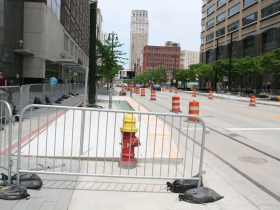
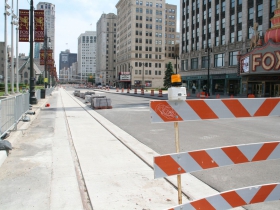
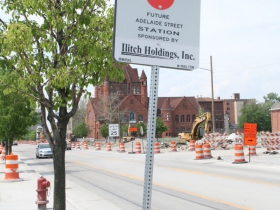
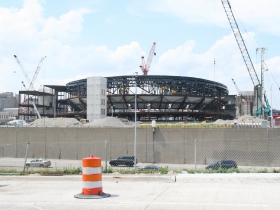
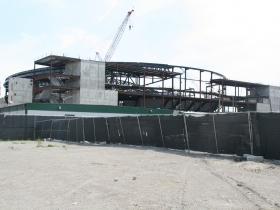
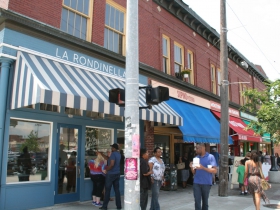
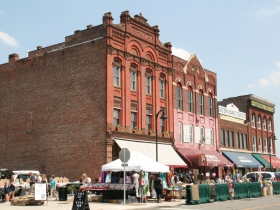
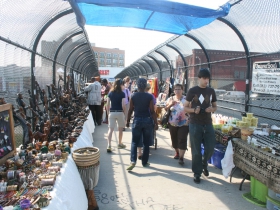
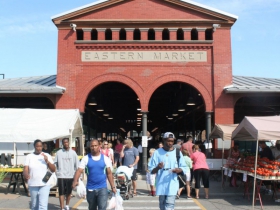
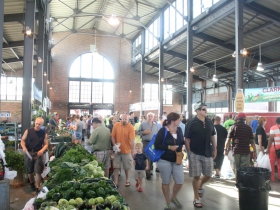
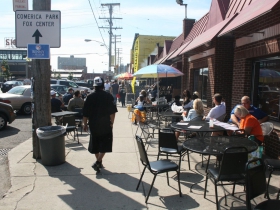
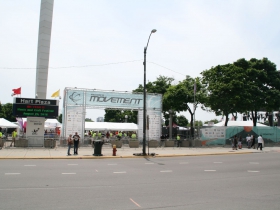
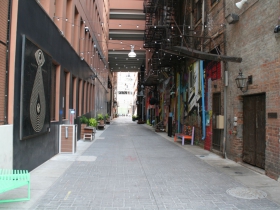
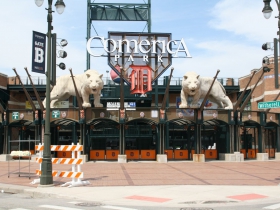
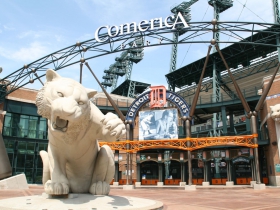
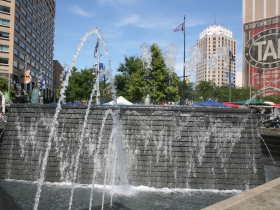
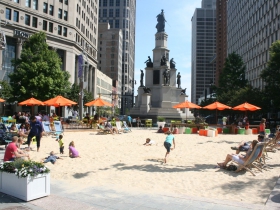
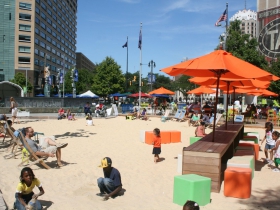
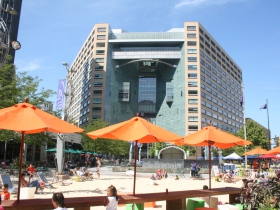
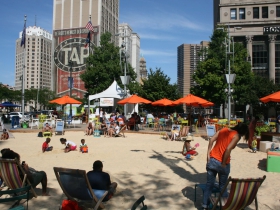
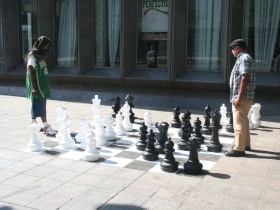
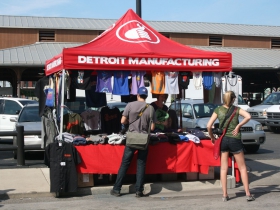
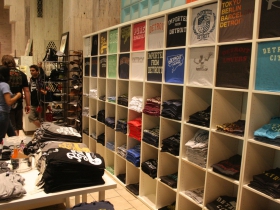




















Milwaukee does beer gardens well. How about one downtown, instead of a beach?
Article summation: “Hey Milwaukee, be unique by copying this!”
We could learn from some of Detroit’s recent wins & it’s good to hear you had fun on a recent trip there… but how do you put some of your suggestions in action? What’s already drawing people to Milwaukee… let’s do more of that… be more of what we already are. Be a better Milwaukee… not try to be a knockoff of Detroit of all places.
^^^^Well said
You want civic spirit, then embrace Milwaukee’s history and traditions. Dispense with the bland marketer names “East Town” and Westown”, they are the essence of Ugh! Milwaukee is Juneautown, Kilbourntown and Walker’s Point. These are the names that built this city, these are the foundations and they are unique in all the world. Don’t try to be Midwest City. Be Milwaukee!
Couldn’t agree more, Alba. I think there needs to be a beer garden involved with the improvements to O’Donnell park downtown. Would be a great location for it, and a great draw to a park that seems an afterthought next to the Art Museum.
I don’t think “beach” and “beer garden” need to be mutually exclusive. The area between the War Memorial and the Kite Store in Veterans Park would be perfect for a small city beach with a great view. That area is dead most of the time anyways.
I can appreciate the “undeveloped” nature of most of Milwaukee’s lakefront, but I think if small portions of it were activated with some sort of usable space that this city’s residents would get more benefit from being right on the gem that is Lake Michigan.
@Joe – I failed to add this point (for the sake of brevity), but I think the parks that are best suited to upgrading are on the west side of Downtown. Zeidler, Pere Marquette and Postman. The Spot project identified the correct area of the city to activate. A beer garden is a logical inclusion.
@Tim – That wasn’t my point at all. I don’t think having civic pride or focusing on getting things done would make Milwaukee less unique. Nor did I advocate for exactly copying the beach or Eastern Market. They’re just guides for how spaces that would otherwise be largely underused can be activated.
I think reducing the feeling of separation between Downtown and the lakefront would pay big dividends. As I mentioned, the Lakefront Gateway Project starts this. Future plans for O’Donnell Park could aid it, as could filling in the surface parking on the eastern side of the Historic Third Ward.
Nice Pipe dream…but NO
A. Unlike Detroit, there is no leadership here….we have a do nothing Mayor & County Executive.
“City services are 1000 times better than MKE & there’s bus system runs 24hrs, Unlike MCTS which is said to be shutting down in 2017”
B. There is no civic pride in milwaukee…in Detroit, everyone is all-in on making Detroit a better place.
No so here….
C. People of Detroit dont live in fear of right-wing talk radio like u do here in milwaukee, the way people here let mark belling punk them is unreal.
Thanks Jeramey for articulately important subtle points along with concrete suggestions.
Civic pride is an intangible, but it can be felt and shared. It’s beyond mere boosterism. In some respects it reflects deep-felt optimism, even when facing hardship. I sometimes sense defeatism in Milwaukeeans. It comes out in large and small ways. For example, although we once had one of the country’s great park systems we’ve defunded it for so long that some, including elected stewards, believe we just can’t sustain it any more and should let it go in piecemeal fashion.
Or since we struggle to solve problems that most big cities face, maybe we should just abandon certain areas and stop worrying about them.
Also, it’s not enough to simply have public spaces–they also must be places people want to be and connected within a network. And yes, beer gardens are in Milwaukee’s DNA but surely there are other innovative things beyond trusty alcohol that could draw us to collectively enjoy public places.
Among cities of all sizes Milwaukee is an outlier, especially downtown, in not being part of a 21st-century approach to valuing and smartly using public spaces on a daily basis (beyond our glorious lakefront). It’s not even all about money (though you have to invest at least a bit). It’s more about vision and recognition that the public realm always works in tandem with the private realm. You can use metaphors from it being the glue, arteries, etc. Milwaukee already has the “good bones” of an exemplary park system, which can be revived with TLC and energetic vision.
There still is can-do spirit here, but perhaps we are not hearing that enough from inspiring leaders, elected or otherwise.
I’ve been a big fan of Detroit since way back before it was cool — lived there for three years back in the early1990s and fell in love with the people who I believe are among the friendliest and most genuine around. A part of that may have to do with not having much less to lose. There is a certain, bittersweet pride in being down on one’s luck (like Detroit has been for decades) after decades of a proud history. Milwaukee has a different pride, one borne of its own uniqueness and history, fueled by the feeling of existing in the shadow of Chicago.
That said, while I’d love for Milwaukee’s business community to be more forward-thinking, Milwaukee often seems a couple steps behind which. Caution can be a good thing if the only alternative is going too far. I believe there can be an exciting middle ground when great things happen and failure is not the only alternative. Detroit has advanced quickly because of its angel investor, Dan Gilbert. He has taken Detroit great steps ahead of where Tom Monaghan and the Tigers and any downtown casino have taken Detroit. And, we need to acknowledge that the downtown renaissance and the arrival of (largely) young white folk are only a small part of the fullness of Detroit and that there are huge challenges in the neighborhoods well beyond what Milwaukee will ever experience.
While copying or stealing isn’t a bad thing, Milwaukee needs to build on its own strengths. Some of the old strengths (ethnicheritage, etc.) are a bit passe now. Not saying that the city needs move beyond brats and fests, but let’s take a look at the next big things. Freshwater sciences and tech? Beautiful! The most durable next big things will be homegrown. At least I suspect that will be the case.
You guys know there is more to cities than just the downtowns and where the yuppies live right? I think I’ll take Milwaukee in that regard.
@Lamont…… it’s ironic, but you’re exactly the negative type of person people are referring to.
I have a couple suggestions and observations. First, I think Milwauke has made great strides in spite of the outdated “shared revevenue” and political structure we have in the is state. People have made careers and a lot of money in tearing our region apart. With that said, I have never seen so much energy and pride in Milwaukee since I’ve been alive. I’m amazed every time I walk or drive around.
I want millennials to stay and embrace Milwaukee. If you don’t like something, rather than run off to the suburbs, stay and help make change.
Milwaukee is a really cool city, but we don’t seem to understand downtowns like we do neighborhoods. I don’t know why, but public space that attracts different people from various backgrounds doesn’t seem to be our strength but we’re improving.
Let’s not starve our assets and services. Transit is on life support, parks are under funded, the Domes are disiegrating. A penny tax would go a long way.
I’ll throw one suggestion on the pile. Why doesn’t the Lake Express Ferry pick up and drop off downtown? I’m sure there is a reason but it would be cool.
Being a Detroit native who now lives in Milwaukee I find this article completely ironic. Everyone I know from back home complains about the city of Detroit and thinks it’s the worst place of all time. When they come visit me here they can’t stop raving about Milwaukee and how great they think it is. Now I’m reading an article from Milwaukee talking about what is better about Detroit.
I love Milwaukee and most people in my neighborhood seem to think Milwaukee is great too so I’m not sure if the criticism that Milwaukee doesn’t embrace the Home brand is completely true. If anything I think the problem is local suburbanites trash talk the local city and I think that’s true in both areas. I work in the suburbs of Waukesha County and it seems to me that just about everybody out there bashes the city of Milwaukee in the same way that everyone I know from suburban Detroit bashes the city of Detroit. I think this tendency is a drag on both regions.
I personally love the city of Detroit and I enjoy going back to see the progress happening downtown but I think downtown Milwaukee and its surround neighborhoods are way more livable and provide better quality of life.
The problem with Milwaukee taking advantage of “Game Days” is that Miller Park is isolated on the west end of the Menominee Valley. In Detroit, Comerica Park, Ford Field, and the new Wings Stadium are all in downtown. When you go to the game you have to walk through downtown and there are plenty of places to hang out within 2 or 3 blocks of the stadium. It’s always seemed to me that Miller Park was poorly placed.
If I were going to steal something from Detroit for Milwaukee it would be coney islands or Detroit style pizza.
LOVE the beach idea!
Detroit has a style of pizza?
Thanks for the article! Cities of all stripes have things they can teach others and it’s great to find the positive in other places to see if they can be adapted in your own city. Same of course can be said for the negatives as well (as we’ll see in the follow up piece I’m sure).
Thanks for bringing some of these ideas forward. Although the idea of a beach within the breakwall is not the most appealing idea to me…
http://www.eater.com/2016/1/19/10787414/detroit-style-pizza
Yes, please! I’d like some NOW.
The loss of a Residency Requirement in Detroit (like Baltimore) has severely reduced the number of resident/employees in that city and has really hurt its revenue. Presently well-less than half the city workers live in Detroit. Thanks to Walker, and Alberta Darling, Milwaukee is now in the same decline in revenue, and home sales in many neighborhoods have dropped noticeably. (My definition of conservative doesn’t include radical changes in policies that have worked for decades. And no, despite their claims, MPS has not had a glut of suburban folks coming to teach for MPS, either)
We need to take back the state from these irresponsible republican meddlers and rescind the law they imposed (specifically aimed at Milwaukee) preventing us from keeping the residency requirement that has worked well for us for 60 some years. (And they complain about “Federal Over-reach”!) I’m speaking as a teacher who has lived gladly in Milwaukee, sent 2 kids through MPS with terrific results, retired, and plans to stay here!
It’s disappointing that The Spot 4MKE closed down. As someone who covered the project for Urban Milwaukee as an intern, I found that it had a lot of potential to liven up the downtown area. But I guess there was too little activity to keep it interesting and people quickly forgot about it.
I think the biggest problem with The Spot 4MKE is that it isn’t really all that attractive of a space. While the paint job certainly adds some color, it doesn’t help matters when the surrounding area is dull and gray. And when there weren’t any people there, it just regressed back into a cold, boring parking space.
To quote Matt Wild’s article in Milwaukee Record, The Spot 4MKE “seemed to fall into the same “lipstick-on-a-pig” trap that plagues so many “placemaking” projects: No matter how many picnic tables you toss up, no matter how many trees you wrap in crepe paper, and no matter how brightly you chalk the asphalt, you’re still stuck with a big, ugly parking lot. And nobody wants to hang out in a big, ugly parking lot.” (http://milwaukeerecord.com/city-life/spot-4mke-boon-bust-depends-whos-reporting/)
Spaces like Detroit’s downtown beach look genuinely fun to be in even if there aren’t any activities happening at the time, as we can see from the pictures. If we can design a place that looks inviting, then we can see more consistent attendance from people. And with regular events like a beer garden or a concert, attendance could rise even higher.
Hopefully we can see new spaces that learn from The Spot’s shortcomings and revitalize downtown and beyond. If not a beach, then something just as fun.
AND THE HOAN BRIGE SHOULD BE REPAINTED THE COLOR OF “INTERNATIONAL ORANGE!”
AND THERE IS A TREASURE HIDDEN AT 212 W. WISCONSIN AVE.!
AND THE VAST STRETCH OF W. WISCONSIN AVE. WEST FROM THE RIVER AND TO N. 6TH ST. SHOULD BE COVERED BY A LIGHT-FILTERING, GLOWING, CALATRAVA/MITCHELL PARK-INSPIRED DOWNTOWN DOME!
AND A GIANT, YEAR-AROUND FERRIS WHEEL SHOULD BE BUILT JUST OUTSIDE OF THE NORTH ENTRANCE TO THE SUMMERFEST GROUNDS!
AND WHAT WAS DESIGNED AS OUR RIVER WALK SEEMS TO ME AS ONLY A BARE, CEMENT SIDEWALK NEXT TO A RIVER! NOW THERE ARE NO TREES AND ONLY LIGHT POLES ALONG A BARE, CEMENT SIDEWALK TO FEW DESTINATIONS! IMAGINE TREES AND STRING LIGHTS ALL ALONG OUR “RIVER WALK!” MILWAUKEE SHOULD LEARN FROM SAN ANTONIO!
AND W. WISCONSIN AVE., ALONG MARQUETTE UNIVERSITY, FROM N. 10 ST. TO N. 16 ST. SHOULD BE PERMANENTLY BLOCKED OFF TO RECREATE ONE IDYLLIC, OPEN, SERENE, SAFER ENCLAVE OF CONTINUING EDUCATION COVERED BY TREES AND SURROUNDED BY GRASS, NOT INTERRUPTED BY THE NOISE AND SIGHT AND SMELL AND DANGER OF CARS AND BUSES!
AND OUR MILWAUKEE COUNTY PARKS SHOULD BE FURTHER ENHANCED!
AND OUR CHILDREN MUST BE NOURISHED !
AND OUR POOR MUST BE NURTURED!
Jack Fennimore, thanks for your insights about The Spot4MKE, and for your earlier reporting. I hope you’ll follow it up with another article. One factor in that project was that it was meant to be transitional toward creating a permanent public space—not an end in itself. That takes time and openness to experiment (which implies the need for acceptance of misfires.)
A model for that is Pioneer Square in Portland, which came into being after experiments over years with transforming a surface parking lot. The potential for reimagining 4th & Wisconsin was why Project for Public Spaces and Southwest Airlines got involved by providing a grant. And it seems the major reason the city did not renew the lease was that suddenly there’s more interest in development of that space after almost 30 years.
The big issue now is whether city officials (and others) will recognize the potential value of having a dynamic public space as part of West Wisconsin Avenue? They can easily reserve a portion for that use rather than selling the whole square block for commercial redevelopment. It’s one of those once-in-a generation decision points.
Will Milwaukee make the leap to a 21-century concept of public spaces as most other major cities have already done? We can’t leave it up to developers to decide what our city’s “public spaces” will be.
We don’t need to “imitate” what other cities have done. But people can drive to Madison, Chicago, Minneapolis or even DesMoines to see what they are doing with downtown public spaces and maybe get inspired about possibilities. (Or invite former Charleston mayor Joe Riley to talk about the topic, or former mayors Rybak and Daley or Madison’s Soglin).
Or watch the excellent recent PBS doc “10 Parks That Changed America.”
http://www.pbs.org/program/ten-that-changed-america/10-parks-changed-america/
Urban public spaces that draw people on a daily basis are extremely good economic generators. But that does not happen by accident. Are we willing to make the effort to make our public spaces better (or create new ones)? The farmers markets and concert series are a good start but there could be so much more.
It’s in Milwaukee’s civic DNA to be a leader in parks issues. We can do this!
It’s in Milwaukee’s civic DNA to be a leader in parks issues. We can do this!
Hate to break it to you but no we can not
3 reasons has to why
A: no civic pride in MKE. (Small-man syndrome)
B: a do nothing country board and County Executive
C: WISN 1130AM will scare people away from any parks project
Lamont: Your points are well taken as to the current Milwaukee climate overall relating to parks. However, I was referring to our city’s long and glorious history, some of which may be forgotten.
Some key aspects of that DNA relating to parks:
A. Christian Wahl and other parks pioneers had the wisdom to entice the very busy Frederick Law Olmsted (father of American parks) to Milwaukee in 1892 when he was designing the Chicago’s World’s Fair landscapes. Olmsted designed the beginnings of our park system with Washington Park plus Lake and Riverside parks linked by the Newberry Boulevard parkway, and planning for what became Lincoln Memorial Drive. Milwaukee is one of a handful of American cities with an Olmsted-designed “system” of parks.
B. Charles Whitnall, a Socialist civic leader for decades, built upon Olmsted’s parks and ideas about park systems and parkways to mastermind our parks system. The father of Milwaukee parks was a remarkable and tireless visionary and Whitnall Park is just one reflection of his great vision.
C. The 4th & Wisconsin Ave. site is owned by the city, not the county. Far-sighted city officials could take leadership in setting it aside. That could be a great legacy for whoever chooses to champion such a vision.
D. As for civic pride, it can increase, like personal self-esteem. It’s based on stories residents tell each other about their city. Those narratives can change and often do.
The great legacy for 4th and Wisconsin is to finally oversee a project that fully utilizes one of the most valuable and beneficial pieces of land in our city for development. This is a prime space to enhance our convention capacity through hotel rooms and add to the active street life of West town. We have 3 parks within a short walk of this location, adding another here would be a waste.
I love this conversation.
The 4th & Wisconsin site is critical. We all get that. Let’s hope no one screws it up.
The City already knows that it wants to set some of the site aside for either/or both the streetcar extension and bus rapid transit (BRT). Sounds like we’ve got the basis for a great, functional public space right there–as a “junction” or “station.” linking the two new transit systems. People will already have a reason to be there (beyond whatever the functions of the development will be (commercial, retail, hotel, residential). Parks aren’t the only kind of public space that people want or a city needs, and I love envisioning a space with a degree of built-in functionality and purpose.
Perhaps this is where Milwaukee can “steal” something from cities like San Francisco. I’m especially thinking about two forms of public or open space:
1. URBAN LIVING ROOMS – There are a couple of buildings currently being built in SF that include this concept, that “blurs the lines between public and private” and also allow for a degree of flexibility for events and special uses. While Milwaukee’s climate is different than that of SF, it looks like the first level of the Moderne approaches what we’re talking about, here:
http://sf.curbed.com/2014/6/10/10089562/urban-living-room-will-surround-transbay-block-8-tower
http://www.som.com/news/soms_leed_platinum_350_mission_tower_offers_an_urban_living_room_to_san_francisco
2. PRIVATELY-OWNED PUBLIC OPEN SPACE (AND ART) [POPOS] – I believe SF pretty much wrote the book on this concept: requiring developers to set aside and maintain a certain amount of space that is forever open to the public as a prerequisite for building. It rightly presupposes the real and monetary value of having such spaces available to citizens and visitors.
http://sf-planning.org/privately-owned-public-open-space-and-public-art-popos
Anyway, food for thought…
I have tracked the conversation here with interest, as Creative Alliance Milwaukee was the lead organization on The Spot 4MKE initiative. There’s so much I want to share with all of you and the rest of Milwaukee about what the real goals of the initiative were, what was accomplished and by whom (there were dozens and dozens of area creatives and organizations involved, something I don’t think most people understand), what didn’t work and why, what The Spot sparked in the area, and what was planned for this year and beyond at the site that we did not get the opportunity to implement with the City moving forward with an RFP for development. What the team had laid the groundwork for and were gearing up to implement iteratively over time was very cool and fresh and, based on initial reaction in the creative community and the comments here, would have gotten Milwaukeeans excited.
This article introduces a complex topic, because just below the surface what it’s really about is Milwaukee’s self-image, our ability to innovate, our tolerance for testing of new ideas, our leadership, politics, racial equity, power brokers and breakers and beyond. The Spot 4MKE project grappled with all of that and more. Perhaps we all need to meet for a beer to have this conversation, as it deserves more than a few lines in a comment section.
I do want to clear up some misnomers right here, however. First, The Spot 4MKE concept or any other public space ideas being floated are not of the “park variety.” Those who raise the issue that there are three parks in the area miss the point of placemaking. “Public space” does not equal “park.” Second, The Spot 4MKE was not meant to be a non-stop circus of entertainment and activity. The “nothing planned” moments cited by many as reasons for “flop” were just as important as the planned ones. Moments like when the taxi driver laid out his prayer rug in the center of the big blue circle in the middle of the afternoon, or a little boy’s mom set out a mat for him to play on with his toy cars while she practiced with the Brazilian drum corps Samba Da Vida at The Spot (for free and unmolested, because CAM held a permit for activity to take place there), or the college kids goofed around on the painted Giant Twister, or the homeless man helped me set up umbrellas in the picnic tables, or families from totally different parts of town built a tower out of blocks together. Those things never would have happened in a parking lot. But they did happen in a little parcel that was carved out of a parking lot to create a safe, inviting, low-key public space in the midst of a dreary, ugly scar of a location. Virginia had it correct when she commented about how it takes time and openness to develop a place and cited Pioneer Square as an example. It took TEN YEARS for that to evolve. The Spot 4MKE was ended less than 1 year after receiving the grant from Southwest Airlines and after less than 6 months of actual programming and activity. You can’t pass a verdict on a place or a process that never had the breathing room required. Not if we, as a community, want to evolve, elevate and innovate.
I, along with the team of area creatives who helped shape The Spot 4MKE concept, have spent a lot of time—several years, in fact–thinking about, discussing, researching and testing ideas that could be genuinely Milwaukee, authentically cool and absolutely uplifting for our collective self-image. But, hey, if everyone wants to just be Detroit, that’s cool too. If you are interested in creating something genuinely Milwaukee, however, let’s meet for that beer to discuss.
I attended the CNU conference last week and took in the beach, the Eastern Market and the general vibe of Detroit. Your 5 points really captures the things I experienced in the 48 hours I was there. The beach was a combination of a bar and a beach for the kids which worked great. The public space is sponsored by the surrounding buildings. This an idea that is transportable to Milwaukee. The space evolved as the evening progressed towards an adult crowd. Teenage kids arrived at the square in the early evening with lit up bikes. Later I toured the edges of downtown with huge areas that have been leveled. Milwaukee has the advantage of people living downtown and in the surrounding neighborhoods but things are happening quickly in Detroit only 3 years away from bankruptcy.
As Midnight Son noted, privately owned publicly accessible space (POPS) is a growing trend. It started in NYC in the 1960s as way to allow higher density in exchange for developers creating much-needed “public spaces.” There were some good ones created and many dismal failures, as reported in 2007 in a thorough inventory. NYC has since cracked down on criteria for POPS. http://www1.nyc.gov/assets/planning/download/pdf/plans/pops-inventory/pops-inventory.pdf
There’s also an interactive website for citizens to help monitor and promote POPS so they best serve public needs.
http://apops.mas.org/
San Francisco and others also codify and promote their POPS (Seattle does tours). Milwaukee does have POPS, the Riverwalk being a big network of them. There are Riverwalk guidelines but not for other POPS, except having a public easement. Since this hybrid is becoming more common here it could help if citizens get involved in what they are meant to accomplish. Otherwise that’s left to developers and chance.
One well-known POPS is Boston’s Post Office Square (Norman B. Leventhal Park). It’s been called “an urban living room” and a “green oasis in an asphalt desert.”
As Maggie pointed out, not all public spaces are parks. The larger conversation that’s brewing here and elsewhere is how to make the most of Milwaukee’s public realm. Focusing on downtown’s public-space portfolio is a good place to start.
Maggie Kuhn Jacobus, thanks for the informative post. I see your response to my statement on the multiple parks being nearby. It’s not that I’m unaware of the difference between parks and place making, and perhaps I should have explained better, my issue is just that I wouldn’t want the place making efforts to stand in the way of the best possible use for that specific location.
We can create artificial reasons to pull people to west town all we want, but ultimately the best way to bring people to West town is to build places to live, work, and stay (hotel) which would actually provide an organic reason for people to be there. Place making and public spaces are extremely positive and beneficial but that doesn’t always mean it’s the best thing to do in an area. The temporary events at 4th and Wisconsin were wonderful, but ultimately in the long run that is not the best use of that parcel.
Milwaukee doesn’t have the same shortage of public spaces that some cities have. And by all means make great use of under utilized areas. However, if we can build real infrastructure that provides tangible assets to benefit the city, the temporary uses must go. To sum up, my comment on the multiple parks was that we have public spaces that are already under utilized near by. If something quality can be built on 4th and Wisconsin to help our convention business, tax base, and bringing residents to West Town then we must step aside and let it happen.
AG, thanks for clarifying and I agree. I should clarify from MY end that I wasn’t suggesting, nor was CAM or any other group planning on, taking up the entire 2 acre parking lot with public space. What I would advocate for is that we as a City and community incorporate intentional, meaningful, planned public space into any development that takes place at 4th and Wisconsin. This kind of “mixed use” space makes a city vibrant, which is the true goal we all are striving for with the endeavor there and with our comments here. Thanks Jeramey Janenne, Jack Fennimore (who reported last year on The Spot for UM) and Urban Milwaukee for the reporting and spurring the dialogue.
AG, I’m not sure if the following is true: “Milwaukee doesn’t have the same shortage of public spaces that some cities have.”
Milwaukee does indeed have a glorious lakefront, one of the best in the country. But there is actually not that much park space in downtown proper where people actually live and work (and are working to draw more people). And connectivity to the lakefront needs to be vastly improved. There’s roughly 30 acres of county parkland and a bit more in city parks in greater downtown. The value of public spaces is in proximity, multiple uses, comfort, etc.
While Milwaukee may not need to add a huge amount of park land downtown, as Jeramey and others have noted, we do need to notch up the quality and programming of its public spaces for them to fully serve current and future downtown workers and residents. That will take fresh views about the 21st-century role of public spaces in promoting a vibrant city. Other major cities are making that push for quality, not just in adding space.
Unclear if the city or the developer would have ownership of the “public” space that would include the 4th and Wis streetcar station, but I’m surprised that so much of the land is envisioned for it in this very early, possible mock-up. Not opposed, per se, just that I envisioned something a bit more “Couture-like.”
Also, a little interesting that Marcoux is saying that all it will take to fund the TIF is a 200-apartment or 200-hotel room development. Likely a message sent to stir interest and proposals, but I hope whatever happens here will be a little more grand. I would love to see at least some residential.
Ack. Meant to include this link in the above post:
http://www.bizjournals.com/milwaukee/blog/real_estate/2016/06/20-million-for-milwaukee-streetcar-extension-to.html
Early Sunday morning… 🙂
Long has Mark Belling is still living, i’ve given up hope on any positive development on 4th and Wisconsin ave.
There is a treasure hidden beside and beneath 212 W. Wisconsin Ave. in downtown Milwaukee, but it is now unknown to almost all who pass by it!
Until a few decades ago, within that treasure even greater riches were discovered!
These riches were closely viewed and are still remembered in detail by many!
Viewers learned to love the glowing beauty of the riches within the treasure hall!
Yet a few decades ago, the treasure hall’s light that displayed the riches was simply shut off!
Now, the treasure’s past glowing glory is dark and hidden and tarnished after past decades of neglect!
The treasure is now beyond locked, steel doors, now impenetrable by almost all!
The treasure is now ignored by almost all who pass by it!
The treasure is now broken, but not beyond repair, yet the riches within may never shine again!
Until a few decades ago, devoted viewers of the riches freely and happily entered the lighted treasure hall beyond the steel doors. Immense, mirrored and marbled walls surrounded a long, 2-story entrance-way. The wall sconces, chandelier, handrails and other decor were of an Art Deco design. Most devotees used to walk on plush, red carpeting that would lead them onward and then downward to the main area where they viewed the riches. Others walked up one of the two grand staircases that led to the balcony from which we could view the treasure hall around us, below us and still high above us. All total, guests had about 2200 seats to choose from.
Upon entering the lower, immense, open, 4-story viewing chamber within the treasure hall, guests would marvel at the plush, dark redness from the expanse of seats and at the red-curtained, ornately-carved and curved walls. The treasure hall organ was positioned at the front of the viewing chamber, surrounded by highly vertical, narrow and delicate pipes that would occasionally fill the viewing chamber with a towering overture played by a master.
I began working in the treasure hall starting in 1966, at the age of 16. I was one of the boys in a tuxedo who greeted the viewers and helped open the closed doors. I ushered viewers eager to have their minds absorbed into the glowing, moving images on the curtained screen.
Heroic images!
Single images flowing together to tell stories rich with beauty and love and crime and terror and much more!
And there was music, powerful, dramatic, moving music, surrounding and weaving through the images on the curtained screen!
***
This treasure hidden is sadly closed, but is still located at 212 W. Wisconsin Ave. The glowing beauty of the riches within the treasure hall were, of course, the many movies shown to viewers since the beginning of the theater’s birth in 1933 until it shamefully closed in 1995.
It was originally built in 1933 for as part of the Warner Brothers movie empire for about $2.5 million at a time when major movie studios built their own movie theaters in major cities across the country. Those theater treasures were often immense, ornately decorated, secular cathedrals where movies were shown to viewers wanting to escape the depression with entertainment.
The treasure hidden was named, at different times, The Warner, and then The Centre or The Grand movie theater when it was purchased by the Marcus Corporation.
As I wrote before, I started working as an usher at the then Centre Theater in 1966, at the age of 16. At that time, it was THE movie theater in a very busy and thriving downtown area. I worked evenings and weekends and we were usually busy, especially if the movie showing was of a good quality.
As I wrote before, I wore a tuxedo and also a bow tie and I carried a flashlight in case the projector would go out or to shoo shoes from the backs of the red velvet seats. During showings, I usually stood by the doors inside of the theater. I was paid to watch sometimes-great movies, not once, but perhaps dozens of times! I bet I very gladly watched, “How To Succeed In Business Without Really Trying” and “Funny Girl” and “The Graduate” and “Camelot” and “Oliver!” 10 or 20 times! I still remember scenes and songs in detail!
I have to admit, however, that the real reason I wanted a job at the Centre Theater was not to see movies, but to meet “Vendettes,” especially since I attended an all-boys high school. They were the high school-aged girls who worked at the theater selling tickets or popcorn. We all became friends and spent time together outside of work and over time I eventually went on several dates, all innocent enough even for the times, with several of the Vendettes I worked with. So I have many warm memories of working at the movie theater for these reasons as well.
Working right on Wisconsin Ave. from 1966 to 1969, I remember the policemen stationed at every intersection from Plankinton Ave. to 6th, enforcing complete order while making sure to stop anyone daring to walk one step into an intersection a mere second after the “don’t walk” sign would begin to blink.
I remember the Open Housing marchers led by Father Groppi walking by on many consecutive evenings during periods.
I remember Wisconsin Ave. being flooded with running basketball fans after Marquette won the semi-final game of the NIT Championship in 1967.
When I worked downtown from 1966 to 1969, between the ages of 16 and 19, I traveled by bus and felt very safe at any time of the night or day. Downtown was then a very enjoyable, bustling place to work and play.
***
Over the years, however, the downtown area along W. Wisconsin Ave. just west of the river from Plankinton to 6th Street has deteriorated. Most businesses are closed in the evenings and the streets are sadly quiet in comparison to decades past. Citizens now have little need to go downtown in the evenings and would probably feel unsafe if they have to do so. Even the formerly called “Grand Avenue Mall” closes as soon and the business-workers go home.
The Marcus Corporation is still headquartered on W. Wisconsin Ave. in downtown Milwaukee, but continues to expand its movie theaters from the City of Milwaukee to the suburbs. They chose to instead make enormous profits with new movie viewing technology in new, suburban movie theaters. After owning and operating several great movie theater treasures in our downtown Milwaukee for many decades, Marcus shamefully chose to eventually close them all.
Besides my previous downtown reminisces, I have to mention that, after the 60’s, I also worked downtown for over 20 years until I retired 5 years ago. I worked with Wisconsin probation and parole at the State Office Building on 6th and Wells.
Almost every day during those 20 years, I used to take lunchtime walks down and around Wisconsin Ave., often briskly walking to the lake and back in my allotted 45 minutes.
Much of the downtown area has very much improved since the 60s. The lakefront has immensely improved with Discovery World, The Calatrava, the Summerfest grounds and with rising office buildings and condos. There will be an office and housing building boom occurring just north of the immediate downtown area where the new arena will be. The performing arts options are numerous. Marquette University is adding beautiful buildings and landscaping on the campus. The 3rd Ward just south of the immediate downtown area is booming with new restaurants, other businesses and condos.
As recently reported by the Milwaukee Journal Sentinel, “The 44-story Couture would join other nearby lakefront projects, including the 18-story 833 East office building, under construction at 833 E. Michigan St.; a 200-room Westin Hotel, planned for about a half-block south of E. Michigan St., between N. Cass and N. Van Buren streets; Northwestern Mutual’s 32-story office tower, under development south of E. Mason St., about a block west of N. Prospect Ave.; and the Lakefront Gateway project, which includes shifting I-794 exit ramps to create a new development site south of the transit center, as well as street, walkway and public plaza improvement to make the lakefront more accessible.”
And yet, the downtown area along W. Wisconsin Ave. just west of the river from Plankinton N. 6th St. continues to become more of an eyesore and becomes more obsolescent with every year that passes.
***
I am old and retired now, but I would like to somehow motivate more active visionaries, be they the few in positions of power or the many who share memories similar to mine. I would like to somehow motivate visionary citizens and leaders of governments and businesses to communicate their hopes and dreams to vastly restore not only buildings, but also public safety and revitalize the downtown area along W. Wisconsin Ave. just west of the river from Plankinton to 6th Street.
I would like to somehow motivate others to then expand dreams into vastly increased, tangible intentions, efforts and investments to vastly restore not only buildings, but also public safety and revitalize the downtown area along W. Wisconsin Ave. just west of the river from Plankinton to 6th.
If these dreams become reality, the downtown lights and life at night will be a beacon for those seeking employment accessible from all areas of town.
It appears to me, predictably, that if visionary citizens and leaders of governments and businesses would agree to vastly restore not only buildings, but also public safety and revitalize the downtown area along W. Wisconsin Ave. just west of the river from Plankinton to 6th, our W. Wisconsin Ave. renaissance should include restoring life to our downtown cinema treasure. The Treasure Hidden at 212 West Wisconsin Avenue must be preserved and revitalized to again display the glow of our great riches…the of our our great movies.
In 1995, steel doors to the treasure hall closed and locked. The treasure hall’s light that displayed the riches at 212 W. Wisconsin Ave. was simply shut off in the heart of downtown Milwaukee! Yet within many memories of visionaries remains the glow of our great riches..the glow of our great movies. Please join us in our efforts to restore and revitalize and to again open the doors of The Treasure Hidden!
I HAVE A DOWNTOWN VISION IN MY HEAD AND IF I COULD I WOULD DRAW IT!
My vision is of W. Wisconsin Ave., west from the river and to N. 6th St.!
West from the river along worn, small shops closed after 5!
West along THE TREASURE HIDDEN which is, of course, the long-closed Warner or Centre or Grand movie palace at 212 W. Wisconsin Ave!
West along The Shops of “Grand Avenue” and the Milwaukee Convention Center and the Hilton Milwaukee City Center and to N. 6th St.!
My vision is of this vast stretch covered by A LIGHT-FILTERING, GLOWING, CALATRAVA/MITCHELL PARK-INSPIRED DOWNTOWN DOME!
A glowing dome that covers a public plaza and protects the vast, pedestrian surface side to side and lengthwise along the stretch!
A long dome of multicolored, but predominately blue stained and painted glass, like an undulating wave rolling and rising from the lake, illuminated by the sun and from within, like beacons of downtown life and hope!
And cars drive east and west on Wisconsin Ave. and approach the inspired three or four or five-story dome and are rerouted to W. Michigan Ave. and W. Wells St.!
And within that long, warm, flowing, glowing dome, small, special shops are reborn and grand, joined shops are reborn, by multitudes of downtown visitors walking on the public plaza, safely sheltered, even during winter storms!
And THE TREASURE HIDDEN again displays the glowing beauty of its riches within!
And The shops of “Grand Avenue” are reborn too!
And the convention center and hotel are reborn too!
And visitors are safely sheltered even during winter storms!
And the downtown lights and life at night are beacons for those seeking employment accessible from all areas of town!
This is what Milwaukee’s W. Wisconsin Ave. downtown area could be!
If you don’t like my vision then please show us a better view, a grander view, perhaps even merging THE TREASURE HIDDEN with THE GLOWING, DOWNTOWN DOME on W. Wisconsin Ave. with THE PROPOSED STREETCAR SYSTEM LINKING THE COUTURE where form and function unite! Merge these THREE downtown visions together into one truly grander plan!
This is what Milwaukee’s W. Wisconsin Ave. downtown area could be!
If you don’t like my vision, then please show us a better view…a grander view…perhaps even!…!
Now would be an opportune moment for the City and County of Milwaukee, along with Marquette University, to again consider closing off W. Wisconsin Avenue from N. 12th St. to N. 17th St. as well as other streets that now intersect the Marquette University campus. City street car traffic would be rerouted from W. Wisconsin Avenue onto W. Wells Street and W. Michigan Street. The Marquette University campus would become one idyllic, open, serene, safer enclave of continuing education covered by trees and surrounded by grass, not interrupted by the noise and sight and smell and danger of cars and buses.